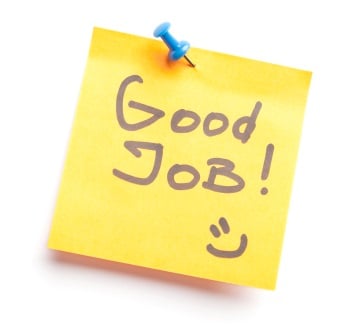Your employee and several co-workers are embarking in a lobby elevator. He has done stellar work lately and you feel it’s important to ”reward” him with recognition in front of his peers so you approach him, pat him ostentatiously on the back and throw in a hearty “Well done, Jones!”
Smiles all around. The elevator stops at your floor where you disembark, feeling proud of yourself for your recognition of a staff member who has earned the accolades.
Everybody’s feeling positive as your recognition just hit the spot. Right? Wrong.
Simply put, recognition and subsequent rewards are serious business; there’s a science to it. It’s not something one simply cobbles together at an elevator door. “Great job!’ or “good work!” are never enough. In fact, they are almost counterproductive.
Meaningful recognition is a process
If you are going to recognize someone, do it honestly and thankfully. Let the employee and his or her peers know exactly why you are praising them. And give them something meaningful that will always recall this special moment at work for everyone involved.
Let’s go back to the beginning to learn how to do this correctly – because proper recognition is a process.
Some basic elements of proper recognition include:
- Developing an attitude of thanks and gratitude with daily reflections in a journal as to why you are truly thankful.
- Recognition is about people and not things so don’t get distracted by the need to give someone something. You will know if and when you should give someone a token of appreciation or not.
- Personalizing the recognition you give to people by having fun with the words you use to express appreciation. Think about how you’ll put a smile on their face with what you say and do.
- Never giving a gift or award alone. It must always be accompanied by the words you express that explain where you’re coming from. If not spoken, at least accompany the award with a note that contains meaningful words.
What does proper recognition look like?
It is not mechanical and does not follow any specific procedure. It is natural. For instance, people who recognize well have learned to tap into their own emotions, even if they were not so naturally inclined beforehand.They draw upon feelings of empathy to better understand what others are going through.
Good recognizers are keen observers of people and behaviours; they don’t miss a thing. And when someone does something amazing they are equally excited to comment and commend. You must enjoy looking out for those instances of great actions deserving appreciation.
When you’re in an appreciative mindset, you can’t help thanking people specifically for what they did and telling them how you and others benefitted from their actons. Generic phrases tend to disappear out the window.
And if you’re still having trouble ditching generic phrases, you can still use them as long as you “customize” them with personal observations.
Giving recognition the right way is an expectation of being fully human. It is learned and developed. Practice by doing and expressing what is in your heart and it will become evident to all that something positive has happened.

